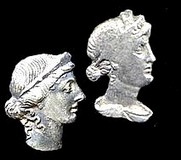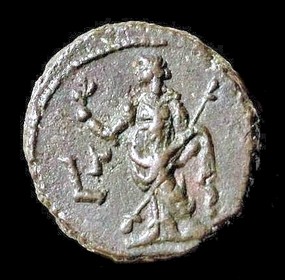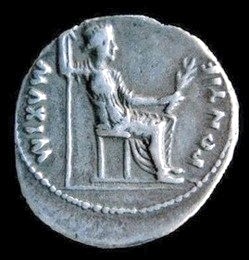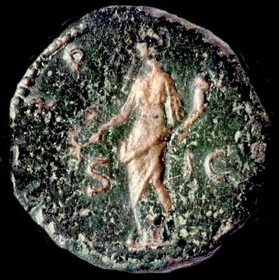 |
 |
 |
 |
Pax, the Roman goddess associated with peace, was worshipped as a minor deity during the Republican era. A festival in her honour was celebrated during April each year. She appears on coinage of the gens Caecilia during 128 BC and is usually depicted driving a biga. On his return from Gaul Augustus officially recognised Pax as a deity and dedicated an altar of peace (Ara Pacis) to her at Rome. Claudius initiated the construction of a temple in her name - it was completed in AD 75 under Vespasian whose coinage occasionally depicted a diademed and draped bust of Pax on the obverse, with on the reverse her name. Sometimes her name appears on the reverse only, with on the obverse imagery of war - i.e. Victory driving a biga. |
Imperial coinage frequently features the personified Pax as a reverse type. She is usually depicted either seated or standing, holding out an olive branch as a peace offering. Sometimes she is shown setting fire to a pile of arms or sacrificing at an altar. Coinage of Elagabalus and Alexander Severus depict her running while holding the olive branch and sceptre. Her attributes also include a sceptre, a caduceus, a cornucopia, ears of corn, a torch or a victoriola. |
Depictions of Pax was also popular on provincial coinage. A very feminine head, similar to her portraiture on Augustan denarii, sometimes adorned the obverse, and was accompanied by the legend PACIS. Occasionally a ploughing scene appeared on the reverse. In the provinces Pax was usually depicted as Eirene, the Greek goddess of peace and wealth whose attributes she shared. Popular reverse types showed Eirene either as seated or standing, holding out an olive branch and is identified by the Greek legend. A typical example is the Alexandrian tetradrachm of Probus, above right, showing Eirene as local deity of peace on the reverse, and on the obverse the Roman emperor. |
 |
 |
Depictions of Pax usually indicated the end of hostilities and the forming of alliances in the Empire and were meant to signify a peaceful colonisation process. Coinage of Hadrian, for instance, featured the personified Pax as a gesture of reconciliation at a time when Rome was expanding her boundaries. However, as a political slogan, Pax not only referred to peace, but also submission to Rome. During the Augustan period in particular, circulation of Imperial coinage bearing on the obverse depictions of the Roman emperor, with on the reverse of the same coin, depictions of the Roman empress (i.e. Livia in the guise of Pax on a denarius of Tiberius, above left) probably contributed to a perception that a conquering Rome followed a policy of peace only through submission. Under the Flavians reverse coin types frequently displayed Pax at times when the Judaean province was in turmoil. Although allusion to Pax was intended to guarantee peace for the entire Empire, this was not always the case in the Roman provinces. |